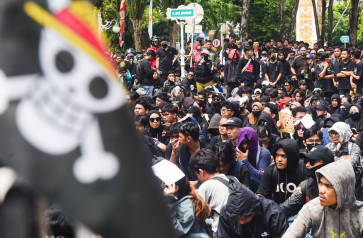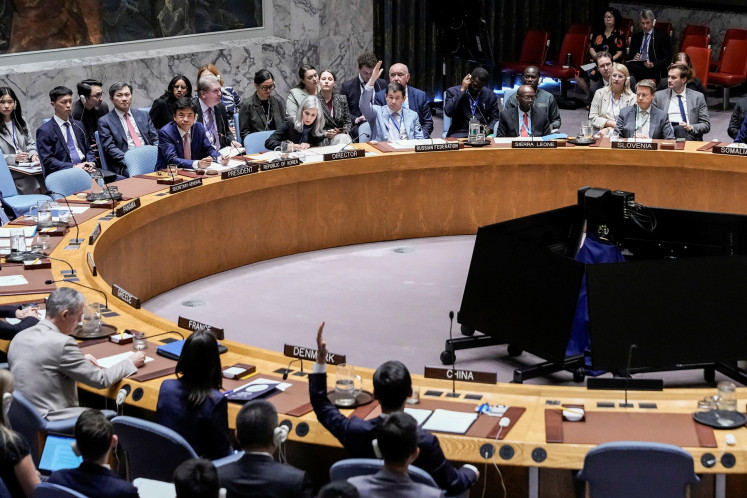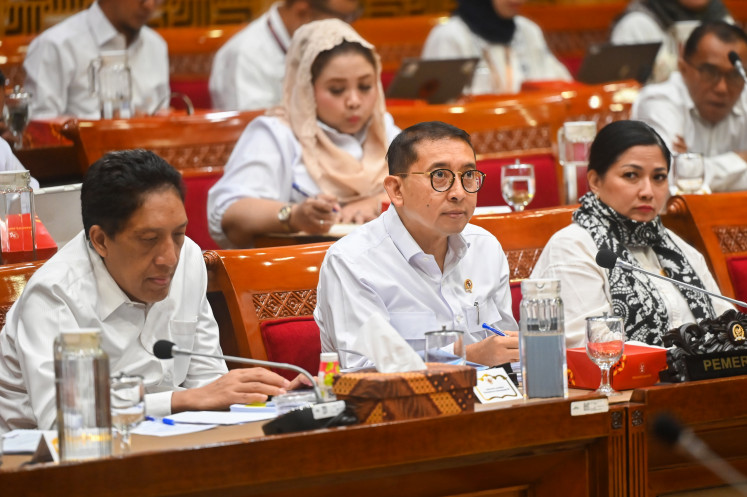Popular Reads
Top Results
Can't find what you're looking for?
View all search resultsPopular Reads
Top Results
Can't find what you're looking for?
View all search resultsGetting to know Sudjojono
Century: Former education and culture minster Wardiman Djojonegoro (second left) speaks with the head of the Jakarta History Museum, Enny Prihantini (second right) after a press conference to discuss painter Sudjojono’s centennial celebrations
Change text size
Gift Premium Articles
to Anyone
C
span class="caption" style="width: 510px;">Century: Former education and culture minster Wardiman Djojonegoro (second left) speaks with the head of the Jakarta History Museum, Enny Prihantini (second right) after a press conference to discuss painter Sudjojono’s centennial celebrations. (JP/P.J. Leo)
The painting of the battle between the king of Mataram, Sultan Agung, and Jan Pieterszoon Coen (JP Coen) the governor-general of the VOC in Batavia, now Jakarta, has decorated the Jakarta History Museum in Old Town, West Jakarta, since 1974.
Painted 40 years ago by Indonesia’s maestro painter S. Sudjojono, the painting in the Sultan Agung room still looks like new. But before 2008, the painting was damaged.
“Some parts of the painting were damaged due to the humidity, dust and other things,” said Enny Prihantini, the museum’s head, during a press conference at the centennial celebration of Sudjojono on Tuesday at the museum.
She said the three-by-10-meter painting had not been restored since it became one of the museum’s masterpieces. In 2000, Sudjojono’s family found that the painting was neglected and reported it to former Jakarta governor Fauzi Bowo.
The museum, in cooperation with the Heritage Conservation Center in Singapore and the Conservation Unit of the Jakarta Cultural and Tourism Agency, conducted a thorough restoration of the painting in 2008.
The restoration included the identification of parts that would be repaired, the frame’s removal, and cleaning, patching and repainting.
Sudjojono’s wife, Rose Pandanwangi Sudjojono, said she hoped the painting would always be well maintained as it was one of the country’s assets that told of the history of the capital.
“We expect the painting to be treated well so younger generations can see that great painting and the history behind it,” she said during a discussion at the museum.
Tuesday’s discussion was the first event in a series of events to mark 100 years since Sudjojono’s birth.
The story of the painting in the Sultan Agung room dates back to 1973, when Sudjojono was tasked by then Jakarta governor Ali Sadikin to create the painting for the museum. He was asked to paint Sultan Agung, who sent troops to attack JP Coen in 1628 and 1629.
Wardiman Djojonegoro said the painting was part of Ali Sadikin’s plan to restore the museum, which was part of the Old Town area’s revamp. Wardiman is one of the members of the group tasked with the restoration.
“When we discussed what should be put in the museum, we suggested that there should be paintings about the history of Jakarta. And he then appointed Sudjojono to do it,” he said.
As the battle took place over 400 years ago, it was not enough for Sudjojono to create the painting only by reading literature about it. But no visual information was available in Indonesia, which made it harder for him to do the painting.
Sudjojono then went to the Netherlands to do research for three months. Accompanied by his wife, he visited museums and libraries in Amsterdam, Den Haag, Leiden and Groningen in search of JP Coen’s visual character, the facts, as well as detailed information about the clothing worn during the period.
From the Netherlands he bought equipment for the project, also ordering canvas from Belgium as there was no canvas of the size he wanted available in the Netherlands.
Sudjojono set up a studio in his house in Pasar Minggu, South Jakarta, that could fit the canvas.
“He was first told by the administration to paint at the museum, but he refused. He said that if he painted at the museum, he had to follow the museum’s operating hours, while Pak Djon usually painted anytime he wanted,” Rose said.
Apart from the data he had gathered, he also enacted the battle scenes at his studio by inviting Indonesian and Dutch colleagues to be models to get the expressions he needed.
When the painting was 80 percent complete, the administration asked him to move the painting from his studio to the museum for the visit of Queen Elizabeth in 1974.
He finished the painting in seven months.
And as people can see today, the painting is divided into three scenes; the first depicts Sultan Agung leading the Seban ceremony in preparation for the attack, the second is the scene of the battle that took place near Batavia Fort, and the third depicts JP Coen receiving Kyai Rangga (the regent of Tegal), who was sent by Sultan Agung to make a conditional peace offer.
Aside from the discussion, various events will be organized in different places as part of the celebration, including art exhibitions at the Mask and Puppets Museum in Ubud, Bali, in October, and the Nanyang Technological University in Singapore.
The main exhibition will be held at the National Museum in Jakarta in December and will feature not only Sudjojono’s paintings from his family’s collections, museums and private collectors, but also his pictures, letters, writings, and video and audio.
There will be a theatrical performance by the Jakarta Arts Institute (IKJ) that will tell of Sudjojono’s life from people who were close to him.
“We want the exhibition to be personal, so that people today can know who Sudjojono was,” said Santy Saptari, the curator of Sudjojono’s Centennial celebrations.










